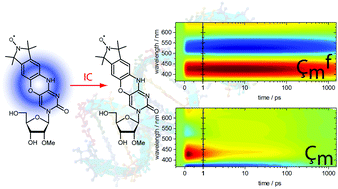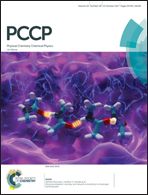Spin the light off: rapid internal conversion into a dark doublet state quenches the fluorescence of an RNA spin label†
Abstract
The spin label Çm and the fluorophore Çmf are close isosteric relatives: the secondary amine Çmf can be easily oxidized to a nitroxide group to form Çm. Thus, both compounds can serve as EPR and fluorescence labels, respectively, and their high structural similarity allows direct comparison of EPR and fluorescence data, e.g. in the context of investigations of RNA conformation and dynamics. Detailed UV/vis-spectroscopic studies demonstrate that the fluorescence lifetime and the quantum yield of Çmf are directly affected by intermolecular interactions, which makes it a sensitive probe of its microenvironment. On the other hand, Çm undergoes effective fluorescence quenching in the ps-time domain. The established quenching mechanisms that are usually operational for fluorophore-nitroxide compounds, do not explain the spectroscopic data for Çm. Quantum chemical calculations revealed that the lowest excited doublet state D1, which has no equivalent in Çmf, is a key state of the ultrafast quenching mechanism. This dark state is localized on the nitroxide group and is populated via rapid internal conversion.



 Please wait while we load your content...
Please wait while we load your content...